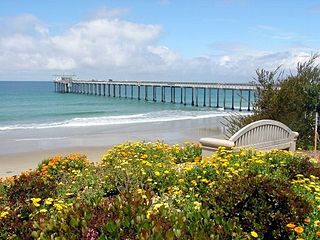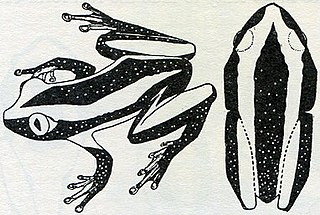Related Research Articles

Camouflage is the use of any combination of materials, coloration, or illumination for concealment, either by making animals or objects hard to see, or by disguising them as something else. Examples include the leopard's spotted coat, the battledress of a modern soldier, and the leaf-mimic katydid's wings. A third approach, motion dazzle, confuses the observer with a conspicuous pattern, making the object visible but momentarily harder to locate, as well as making general aiming easier. The majority of camouflage methods aim for crypsis, often through a general resemblance to the background, high contrast disruptive coloration, eliminating shadow, and countershading. In the open ocean, where there is no background, the principal methods of camouflage are transparency, silvering, and countershading, while the ability to produce light is among other things used for counter-illumination on the undersides of cephalopods such as squid. Some animals, such as chameleons and octopuses, are capable of actively changing their skin pattern and colours, whether for camouflage or for signalling. It is possible that some plants use camouflage to evade being eaten by herbivores.

An octopus is a soft-bodied, eight-limbed mollusc of the order Octopoda. The order consists of some 300 species and is grouped within the class Cephalopoda with squids, cuttlefish, and nautiloids. Like other cephalopods, an octopus is bilaterally symmetric with two eyes and a beaked mouth at the center point of the eight limbs. The soft body can radically alter its shape, enabling octopuses to squeeze through small gaps. They trail their eight appendages behind them as they swim. The siphon is used both for respiration and for locomotion, by expelling a jet of water. Octopuses have a complex nervous system and excellent sight, and are among the most intelligent and behaviourally diverse of all invertebrates.

A squid is a mollusc with an elongated soft body, large eyes, eight arms, and two tentacles in the orders Myopsida, Oegopsida, and Bathyteuthida. Though many other molluscs within the broader Neocoleoidea are also called squid despite not strictly fitting these criteria. Like all other cephalopods, squid have a distinct head, bilateral symmetry, and a mantle. They are mainly soft-bodied, like octopuses, but have a small internal skeleton in the form of a rod-like gladius or pen, made of chitin.

A cephalopod is any member of the molluscan class Cephalopoda such as a squid, octopus, cuttlefish, or nautilus. These exclusively marine animals are characterized by bilateral body symmetry, a prominent head, and a set of arms or tentacles modified from the primitive molluscan foot. Fishers sometimes call cephalopods "inkfish", referring to their common ability to squirt ink. The study of cephalopods is a branch of malacology known as teuthology.

The Scripps Institution of Oceanography (SIO) is the center for oceanography and Earth science based at the University of California, San Diego. Its main campus is located in La Jolla, with additional facilities in Point Loma.

The Marine Biological Laboratory (MBL) is an international center for research and education in biological and environmental science. Founded in Woods Hole, Massachusetts, in 1888, the MBL is a private, nonprofit institution that was independent for most of its history, but became officially affiliated with the University of Chicago on July 1, 2013. It also collaborates with numerous other institutions.

Carcinus maenas is a common littoral crab. It is known by different names around the world. In the British Isles, it is generally referred to as the shore crab, or green shore crab. In North America and South Africa, it bears the name European green crab.
Hopkins Marine Station is the marine laboratory of Stanford University. It is located ninety miles south of the university's main campus, in Pacific Grove, California on the Monterey Peninsula, adjacent to the Monterey Bay Aquarium. It is home to ten research laboratories and a fluctuating population of graduate and undergraduate students. It has also been used for archaeological exploration, including of the Chinese-American fishing village that existed on the site before burning down in 1906.

The common cuttlefish or European common cuttlefish is one of the largest and best-known cuttlefish species. They are a migratory species that spend the summer and spring inshore for spawning and then move to depths of 100–200 metres (330–660 ft) during autumn and winter. They grow to 49 centimetres (19 in) in mantle length and 4 kilograms (8.8 lb) in weight. Animals from subtropical seas are smaller and rarely exceed 30 centimetres (12 in) in mantle length.

The pharaoh cuttlefish is a large cuttlefish species, growing to 42 cm in mantle length and 5 kg in weight.

Roger Arliner Young was an American scientist of zoology, biology, and marine biology. She was the first African American woman to receive a doctorate degree in zoology.

Octopus cyanea, also known as the big blue octopus or day octopus, is an octopus in the family Octopodidae. It occurs in both the Pacific and Indian Oceans, from Hawaii to the eastern coast of Africa. O. cyanea grows to 16 cm in mantle length with arms to at least 80 cm. This octopus was described initially by the British zoologist John Edward Gray in 1849; the type specimen was collected off Australia and is at the Natural History Museum in London.

The plate fish is a flounder in the genus Bothus, found in the warmer parts of the Atlantic including the Caribbean. Its typical habitat is sandy plains near coral reefs and it is able to change its colouring to make it well-camouflaged in this environment. It is sometimes known as the peacock flounder, a name also given to the closely related Bothus mancus from the Indo-Pacific.

Cuttlefish, or cuttles, are marine molluscs of the order Sepiida. They belong to the class Cephalopoda which also includes squid, octopuses, and nautiluses. Cuttlefish have a unique internal shell, the cuttlebone, which is used for control of buoyancy.

Underwater camouflage is the set of methods of achieving crypsis—avoidance of observation—that allows otherwise visible aquatic organisms to remain unnoticed by other organisms such as predators or prey.

Macrotritopus defilippi, commonly known as the Lilliput longarm octopus or the Atlantic longarm octopus, is a small species of octopus, a marine cephalopod mollusc of the order Octopoda.

Gary G. Borisy is a retired president and director of the Marine Biological Laboratory in Woods Hole, Massachusetts. In 2013, Borisy joined the Department of Microbiology at the Forsyth Institute.

Coincident disruptive coloration or coincident disruptive patterns are patterns of disruptive coloration in animals that go beyond the usual camouflage function of breaking up the continuity of an animal's shape, to join up parts of the body that are separate. This is seen in extreme form in frogs such as Afrixalus fornasini where the camouflage pattern extends across the body, head, and all four limbs, making the animal look quite unlike a frog when at rest with the limbs tucked in.

The dwarf cuttlefish (Sepia bandensis), also known as the stumpy-spined cuttlefish, is a species of cuttlefish native to the shallow coastal waters of the Central Indo-Pacific. The holotype of the species was collected from Banda Neira, Indonesia. It is common in coral reef and sandy coast habitats, usually in association with sea cucumbers and sea stars. Sepia baxteri and Sepia bartletti are possible synonyms.
References
- ↑ "Hanlon, Roger T." Library of Congress Name Authority File. Retrieved 2021-07-12.
- ↑ "Hanlon Lab – Overview". Marine Biological Laboratory. Retrieved 2021-07-12.
- ↑ "Roger T. Hanlon". University of Chicago. 3 March 2021. Retrieved 2021-07-12.
- ↑ Zimmer, Carl (2008-02-19). "Revealed: Secrets of the Camouflage Masters". The New York Times. ISSN 0362-4331 . Retrieved 2021-07-12.